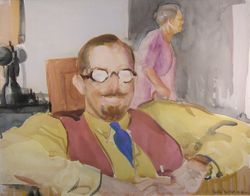|
Barse Miller
(1904-1973)
 | | click image to enlarge |
"Swell Photographer"
1936
Watercolor
17 x 22 inches
Click here to inquire about this work
Barse Miller was born in New York City, ion January 24, 1904, and began formal art instruction at the National Academy of Design while still in elementary school. There he received instruction from Henry Snell. A few years later, he continued his education with Hugh Breckenridge at the Pennsylvania Academy of Fine Arts. Both of these teachers were award winning watercolorists. At eighteen years of age he was awarded the Cresson Traveling Scholarship which enabled him to study and paint in Europe for two years.
In 1924, he moved to Los Angeles and settled. The next year he began exhibiting with the California Art Club and by 1928, was an active member of the California Water Color Society, serving as its president in 1936, 1937, and 1938. His watercolors from this era were quite different than most works being produced on the West Coast. They often included cityscape subjects with people, automobiles and industrial objects. As the new era of California watercolorists, led by Millard Sheets and Phil Dike, emerged in the early 1930s, they welcomed Miller into the movement and revered him as one of the leading figures.
Throughout the 1930s and 1940s, the watercolors of Barse Miller became increasingly popular, and his ability to manipulate wet-into-wet washes had a huge impact on many of his students and fellow artists. His many years of formal art instruction gave him an advantage because of his knowledge of color and design, so when the California Group was being scrutinized in the 1930s, his work helped greatly to give the overall movement credibility.
During World War II, Miller went into the United States Army and became head of the Combat Art Section in the South Pacific. He produced a number of watercolors and was awarded for his artistic contributions that visually documented the war in that region. After the war, he received a Guggenheim Fellowship and eventually settled in New York state and maintained a studio-home in Maine. His watercolors after this period became increasingly modern, as he sought to relate to a changing art world.
During his period in California, Miller taught at the Chouinard Art Institute and, for ten years, at the Art Center School. As a teacher of watercolor painting, he helped many of the most successful California watercolorists to understand the possibilities of this unique medium. In later years, he also made special visits to the West Coast to teach at the Brandt-Dike Summer School of Painting and other watercolor workshops.
In addition to watercolor painting, he also exhibited oil paintings and produced a number of murals.
Miller died in Mexico in 1973.
Member: National Academy of Design (1947); California Watercolor Society (Pres. 1936-38); California Art Club; Laguna Beach Art Association; American Watercolor Society; San Diego Watercolor Society.
Exhibited: Hatfield Gallery, Los Angeles, 1926; Biltmore Salon, Los Angeles, 1927; Los Angeles County Museum of Art, 1928, 1929, 1935; Oakland Art Gallery, 1932; California Palace of the Legion of Honor, 1932; San Francisco Museum of Modern Art Inaugural, 1935; Golden Gate International Exposition, 1939.
Awards: Cresson traveling scholarships, Pennsylvania Academy of Fine Art, 1922, 1923; second prize. Los Angeles County Fair, 1925, first prize, 1930; first prize, Arizona State Fair, 1927; second prize, Logan, Utah, 1929; Hatfield gold medal, California Art Club, 1929; Dyer prize, Los Angeles County Museum of Art, 1932.
Works Held: Burbank Post Office (mural); George Washington High School, Los Angeles (mural); San Diego Museum; Los Angeles County Museum of Art; Art Institute of Chicago; Denver Museum; Portland Museum; Southern California Edison Building, Los Angeles (mural in lobby); Pennsylvania Academy of Fine Art; National Gallery, Melbourne, Australia; Butler Art Institute; Metropolitan Museum; Brooklyn Museum; Glasgow Museum, Scotland; United States War Department.
Source:
www.askart.com
Gordon T. McClelland and Jay T. Last, California Watercolors 1850-1970 Biographical information in this book is based on interview with Betty Miller, 1984 and interview with Rex Brandt, 1983
|
|
|
|
|

